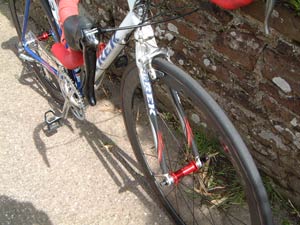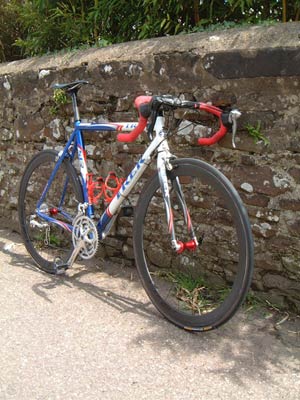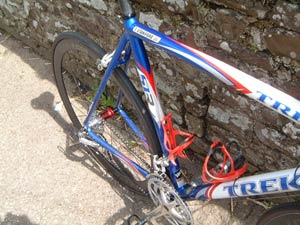 |
I have a Trek 1400, which is a nice bike. And, for £650 in the sales back in 2005, it rides very well. It’s stiff, smooth and comfortable and has never let me down. For training and leisure purposes it fits the bill very nicely, but for races there is one significant weakness- the wheels, which are Bontrager Selects.
Now, don’t get me wrong, I’m no powerhouse on the bike, and my sprint is about as effective as a chocolate teapot on a particularly hot day. Yet whenever the heat is on, and a high sustained speed or nippy acceleration is needed, they are woefully pliable. So much so that it feels the rear wheel is made of jelly at times.
So, I thought, what better cycling item to blow my student loan on than a pair of super-light, super-stiff and super-expensive wheels?
A Man With A Plan
Whenever choosing new bike parts, or indeed a new bike, I always ask myself the same question. What will it be used for?
I’m tending towards the climbing end of the cycling physiology spectrum, not because I can climb well, but because my sprint is so poor. At 6ft 3” and 68kg, I’m not particularly worried about weight limits. I’m light and I don’t have prodigious power so I can get away with something really light. I live in the hills of Devon, and prefer hilly rides and races to flat ones, and you can see here the basic form taking place. These will be race-day wheels only, so we’re looking at something light, fast, versatile (with a particular advantage going uphill), and possibly the most overlooked aspect- they must look good.
A quick Google search hinted that a good deep-section factory-built carbon wheelset would cost between £1000 and £2000 – and for the price, none of them were particularly light.
A quick e-mail correspondence with our beloved [steady – ed.] ed., Richard Hallett, ensued; and he whole-heartedly recommended I look into hand-built wheels. He recommended a whole host of other items worth purchasing, though: stick-on beard, pipe, leather paraphernalia, CTC Membership and so on; but (un)fortunately funds could not stretch to buying these “essential” items- his words, not mine.
Choices, choices, choices…
I followed RH’s sage advice, and started hunting down wheel components and a wheel-builder. I asked around and surfed the interweb at leisure – and at last hit upon a light, aero and rare wheel rim – the Lew Pro VT-1.
Now, most people recognise the Lew name from those ridiculously light at 800g, ridiculously expensive at $17000 dollar wheelsets. What only the discerning few are aware of is that you can go to the Lew website and buy the rims separately- $800 dollars each, working out at the present financial climate at around £450. Not exactly cheap,.. but if you are in mind to buy a superlight wheelset, these 270g 48mm carbon rims are certainly worth a look. They also have a significant advantage in that you don’t need carbon-specific brake blocks.
I can also say that Lew’s Customer Services Dept, like many US companies, is a gleaming well-oiled machine of professionalism and courtesy. Lew also provided the spoke nipples for this rim for a nominal charge of around $20. I bookmarked the website so I could come back to it after finding a wheelbuilder and knowing exactly how many spokes I wanted in the rim.
Next on the list were the spokes- Sapim CX-ray or DT-Swiss Aerolite being the two aero spokes on the top of most people’s lists. Sapim CX-rays won out, purely because my local bike shop could get them in faster than they could the DT Swiss offerings.
The final choices to be made were those regarding the hubs. As the centre of the wheel and home of the ball-bearings, the hub plays a significant part in the performance of the finished product. After weeks of searching for superlight, supercool examples, I hit upon what I now consider to be the holy grail of road hubs, and indeed much road componentry – Tune. Based in Germany, Uli and his gang of techno-wizards churn out countless fine examples of Germanic engineering know-how. The fantastic Mig 70, around £100, weighs about 70g and comes in a variety of colours. I opted for the red purely because I think red and black goes very nicely.[Anarchist – ed.]
 |
If you’re happy having straight-pull spokes, you can buy a Mig 45 for around £150, which weighs – you guessed it – 45g. For the rear hub, I opted for the Mag 160, also in red. All hubs were bought from the lovely people at Poshbikes, and again… I waited until speaking to the wheelbuilder before deciding on spoke counts. All the parts were, therefore, chosen and ready to be purchased- and all that remained was to talk to a wheelbuilder, buy them, and then put them together.
It is a curious fact, known by those accustomed to the ancient and mysterious (and unfortunately, dying) art of wheel-building; that even if you give two wheelbuilders the exact same components and tools, and the exact same time, they will both come up with two very different wheels.
For wheel parts of this calibre, I wanted a really superb wheel-builder to put them together for me. I asked lots of racers and bike shops, and they all said the same thing to me- Chaz. Chaz, Chaz, Chaz- repeated over and over again in a relentless, almost chant-like, monotone. I resolved to hunt the man Chaz down.
We meet at last….
I tracked Chaz down to his subterranean lair (read Exeter Bike Shed) at last. A light fuzz adorning his chiselled jaw, mountain bike cargo pants slung nonchalantly over his ex-BMX racer legs, he smiles affably and offers me a hand shake. The man Chaz is everything I was expecting from a wheel builder. Quiet, confident, enigmatic and mysterious in equal measure. The homo-erotic subtext is reaching dangerous levels, so I will curtail my description by simply saying, he is an artisan. Wheels are his canvas. And if he doesn’t know something about wheels, it’s probably not worth knowing.
A quick look at the illustrious list of people he has hand-built wheels for is quite staggering- amongst the many local and national riders he accommodates, I spot names like Sean Yates, Dave Lloyd and Andrei Burton (UCI-ranked 6th in the world for Trials). If this isn’t enough, Chaz reckons he has built more carbon fibre wheelsets than just about any other builder in the UK, and indeed his technical knowledge of the subject and practical application led him to designing the Royce Carbon-Specific Stealth nipple- which aims to reduce hotspots in carbon rims. He is, quite simply, the MAN, when it comes to carbon wheels.
Tightening the jig…
A preliminary meeting with Chaz (by that, I mean we ate doughnuts and chatted in his office) was executed, and he asked me my weight, ride characteristics, style, etc. Because of my light weight, we opted for a 20-spoke front, 24-spoke rear. When I say ‘we’, I mean that Chaz suggested something and I nodded my head, agreed with him, and pretended I knew what he meant. Thankfully, he has great skill in explaining techniques and concepts alien to the first-time wheel-buildee. Radially-lacing the front wheel helped keep the weight down with reduced spoke lengths, and two-cross spokes on the back wheel (where each spoke crosses two other spokes) provided a bit of extra stiffness. If we really wanted things to be stiff, or if I was a particularly heavy or powerful rider, we’d have gone instead for a 28-spoke rear, crossed three times, and tied and soldered the spokes together where they meet.
A few anxious hours later, I was back in the bike shed to see his handiwork. I knew the wheels would be superlight from my preliminary calculations, but nothing prepared me for their weightlessness. My breath caught in my throat; if I was feeling nostalgic I would say that a small tear formed in my left eye and I felt a blossoming warmth in my heart. To cut a long story short, we glued some Continental Sprinter Gatorskins onto the rims, left them overnight in the warm, and waited for the races to begin.
Testing the wheels…
First time I rode the wheels, I was disappointed. I was really quite unhappy, until I looked down at the speedometer. The reason is this; I was expecting them to be super-stiff, super fast, super-light and aggressive- but this is not exactly entirely true, and it has taken me a while to work out why. When I got out of the saddle and hammered it, I was expecting to feel an immediate surge in speed, and a snappiness in the back wheel as the power is absorbed and then expelled onto the road.
 |
This is not what happens.
What happens is, you get out of the saddle, and the wheels are so light, so smooth, so perfectly poised and balanced, that’s it’s not so much a sudden ‘surge’ in speed over a few seconds, but an almost-instantaneous VIP, velvet-upholstered elevator to top speed. It happens so quickly, and is so smooth, you don’t even notice it properly until you look at the speedo. That is the only way I can describe it.
The back wheel is not springy – it is so stiff that it will take whatever you give it. The thing that throws you off, though, is that this stiffness is never uncomfortable. It is so comfortable, it almost doesn’t feel stiff. It’s completely balanced, completely neutral. It never reacts adversely, and never changes. It just delivers. Again and again and again.
Potholes and road-vibration are dramatically diminished, ride comfort is increased. Getting up to speed at any time is effortless, and maintaining high speeds on the flat is so easy it should be illegal.
It is a singularly weird experience, the first time you go out on them- and they are definitely way above anything I’ve ever ridden in terms of efficiency and performance.
Aerodynamically speaking, they are superb. Under 18mph there is no real difference to training wheels other than comfort, but above 18mph, when you start putting some power down, they are transformed. They will take whatever you give them. They never strain, they never feel flustered, they just do what they’re told. They also sound pretty cool.
There is no other way of describing them properly. Everything is fast, but it never feels fast. They’re so smooth and controlled and just do what you want them to that it almost doesn’t feel like you’re riding on wheels. Even when you’re in 53×12, you feel somehow disconnected, like you’re floating on a cloud and simply pedalling on wisps of cumulo-nimbus.
The tracking and handling is superb; I simply cannot fault it.
They look magnificent.
And the weight? 950g for the pair, without tubs. Job done.
Tom’s Build (approximate prices)
Just as a comparison – Zipp 404, £1500, 1200g (ish, if you’re lucky);
Tom’s wheels, £1560, 950g.
If you would like to contact Chaz Curry for advice or a wheel-build of your own, please feel free to email him at: [email protected]






